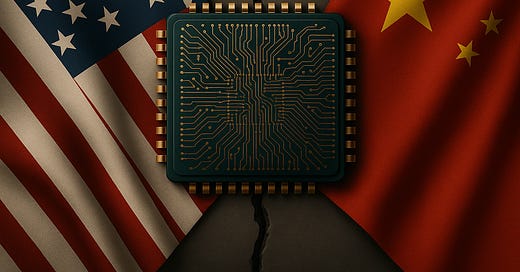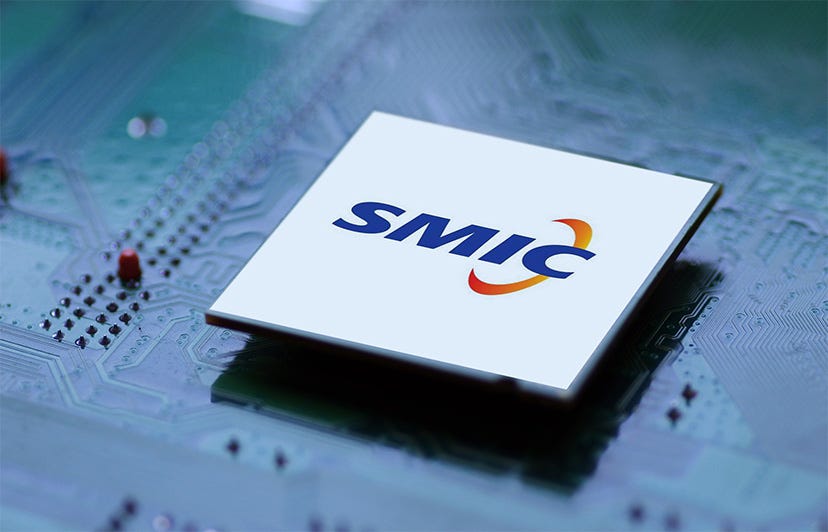China’s Bet on Domestic Tech: The Companies Poised to Gain Amid Rising Tariffs
As U.S. trade restrictions tighten, China accelerates its push for tech self-sufficiency, creating new opportunities for domestic champions.
Welcome to Asia Tech Lens, where we track Asia’s technology rise with perspective, without the hype, and free from rhetoric.
In every edition, we unpack the key shifts in Asia’s tech landscape and what they mean for global markets, industries, and innovation at large.
We’re kicking off with the biggest story shaping the industry: the U.S.- China chip war, and the new class of Chinese companies poised to thrive under pressure.
Chips are no longer just components. They are fast becoming the very foundation of the race for global technological dominance.
Washington has steadily tightened export restrictions to cut China off from advanced semiconductors and AI processors. Earlier this month, the Trump administration imposed new restrictions that effectively blocked exports of Nvidia’s H20 chip, a downgraded product originally designed specifically for export to China to comply with previous chip controls.
These measures have supercharged China’s AI efforts, accelerating a domestic push to close critical technology gaps and reduce reliance on foreign suppliers.
Huawei: Seizing the Opportunity Left by Nvidia
Earlier this week, The Wall Street Journal reported that China’s Huawei is preparing to test its most powerful artificial intelligence processor yet, the Ascend 910D - a direct response to the constraints placed on foreign chip supplies.
The announcement immediately unsettled markets. Nvidia’s shares fell on Monday, reflecting concerns that Chinese firms are making faster progress toward self-sufficiency than many had anticipated.
Huawei is betting that its new 910D AI processor can approach or potentially outperform Nvidia’s H100, depending on application-specific benchmarks. The company has reportedly approached Chinese tech firms to validate its performance.
In parallel, Reuters reported that Huawei is planning mass shipments of more than 800,000 units of its earlier Ascend 910B and 910C models to Chinese customers including state-owned telecommunications carriers and ByteDance.
These processors were designed to plug the gaps left by U.S. sanctions. The Ascend 910C - is a significant upgrade over its predecessor, offering double the computing power and memory capacity. It’s still not quite at Nvidia level - achieving only 60% of H100’s inference capabilities. But in today’s restricted environment, it’s good enough to meet a surging domestic demand.
Huawei’s real swing for the fences, though, might be the CloudMatrix 384. The system packs 384 Ascend 910C chips into a single rack.
As Eli Grant from AInvest puts it, it’s a “brute-force approach to AI training, prioritizing sheer scale over per-chip efficiency. The system delivers 300 PFLOPS of dense BF16 compute, nearly doubling Nvidia’s GB200 NVL72.”
But this he says comes at a cost: it consumes 3.9x more power and is 2.3x less energy-efficient - a trade-off experts say China can afford for now, given its cheaper energy and policy priorities.
Huawei isn’t stopping there. It’s already working on its next chip, the Ascend 920.
Designed for the latest AI models, like ‘Transformers’, which power systems such as ChatGPT, and ‘Mixture of Experts’ architectures, which make AI smarter and faster by dividing tasks among smaller specialized models, the Ascend 920 promises to improve training speeds by 30 - 40% compared to previous versions.
And critically, instead of relying on Taiwan’s TSMC, Huawei is turning to China’s own Semiconductor Manufacturing International Corporation (SMIC), to manufacture the chip using a 6-nanometer process.
If all goes according to plan, mass production could start by late 2025 giving Chinese tech giants a homegrown option.
Huawei may be leading the charge, but it’s not alone. Several other firms are quietly rising as critical players in China’s semiconductor comeback.
Who Else Stands to Gain in China’s Chip Race?
1. Semiconductor Manufacturing International Corporation (SMIC)
If Huawei is the face of China’s chip ambitions, SMIC is the engine working quietly behind the scenes.
As mentioned earlier, Huawei is turning to SMIC to manufacture its next-generation Ascend 920 chip. But SMIC’s significance runs deeper than just one partnership.
In a breakthrough move, SMIC has reportedly succeeded in making 5-nanometer-class chips without extreme ultraviolet (EUV) lithography, a cutting-edge process monopolized by Dutch firm ASML and restricted by export controls.
The news, shared by semiconductor analyst William Huo on X, marks a major milestone. For years, experts believed no one could break below the 7nm barrier without EUV systems. Yet SMIC has proven otherwise, a signal that China’s semiconductor ambitions are finding new ways forward under pressure.
While the process is far from efficient, the result is functional: a 5nm-class chip. Early reports suggest these chips are already powering devices such as Huawei’s Mate 60 smartphone.
Meanwhile, SMIC is significantly scaling up its mature node capabilities with the planned construction of four new 12-inch wafer fabs in Beijing, Shanghai, Tianjin, and Shenzhen. These state-of-the-art facilities will primarily target the 28nm and larger process nodes - a sweet spot for applications in consumer electronics, automotive systems, and industrial equipment. By focusing on these high-demand, versatile nodes, SMIC is positioning itself to support a broader spectrum of industries while boosting China's domestic chip supply.
2. Cambricon Technologies
When Cambricon Technologies landed on the U.S. Department of Commerce’s Entity List in 2022, it effectively lost access to TSMC, cutting off its ability to manufacture advanced chips. For two years, the Beijing-headquartered company struggled on the sidelines, squeezed by supply chain disruptions and sanctions.
But last year, Cambricon staged a comeback few saw coming.
In January this year, its market capitalization surged to RMB 288 billion, second only to SMIC among China’s semiconductor companies.
The reason as per an exclusive report on Tech Taiwan by Liang-rong Chen is surprisingly simple.
“According to a Cambricon supplier I interviewed, the surge came because SMIC(中芯國際)“made a major breakthrough” in its 7nm production capacity. SMIC reportedly scaled up from producing just over 20,000 12-inch wafers per month to over 30,000 wafers per month by early 2025, which is a 50% jump. That means Cambricon’s 7nm AI processors, once manufactured by TSMC, can now be produced domestically by SMIC.”
3. Shenzhen SiCarrier Technologies Co., Ltd
Established in 2021 in Shenzhen, SiCarrier Technologies is a little-known but fast-rising name in China’s semiconductor equipment sector. Closely linked to Huawei and backed by the Shenzhen Major Investment Group, SiCarrier remained largely out of the public eye until Semicon China 2025 in Shanghai.

Stewart Randall, Head of Electronics and Embedded Software at international consultancy Intralink, wrote in TechNode that SiCarrier’s booth was the busiest he had “ever seen at any expo”, what he described as a thousand people crowding around during its press conference.
Much of the buzz centered on whether the company would unveil a lithography machine - a domain still dominated by ASML and subject to export bans.
According to Anue, the company claims to have developed lithography machines for 300-mm wafers on 28nm processes, and plans to launch an upgraded version compatible with ASML and Applied Materials equipment by 2026.
While the lithography tool wasn’t publicly shown at Semicon, the company did unveil 30 other tools spanning etching, deposition, annealing, and inspection, highlighting its ambition to build a full-stack chip equipment portfolio.
According to CTO Chen Dong, SiCarrier’s main clients include major foundries like SMIC and Hua Hong. The Anue report also suggests that the company has partnered with several fabs to set up joint labs and expects to announce its first batch of commercial orders by the fourth quarter of this year.
A Nikkei report quoted by Tom’s Hardware says that SiCarrier is already partnering closely with Huawei’s internal chip team to identify process bottlenecks and potentially build a proprietary production flow based entirely on Chinese tools. A long-term bet, but definitely one with strategic implications.
Why This Matters
A new generation of companies is racing to fill the gaps left by U.S. sanctions. The Chinese tech economy comprises tens of thousands of companies from startups to established players which are not known outside China. Whether they succeed in scaling globally or remain strategically important only within China, one thing is clear: the next phase of the tech race will be fought not just in code, but in silicon. Technologists and investors would do well to watch this space.






